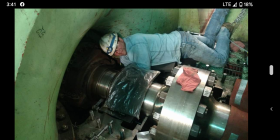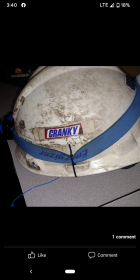You are using an out of date browser. It may not display this or other websites correctly.
You should upgrade or use an alternative browser.
You should upgrade or use an alternative browser.
Align Boring The Struts And Stern Tube In A New Corps Of Engineers Push Boat
- Thread starter jackieschmidt
- Start date
jackieschmidt
Gold $$ Contributor
Last edited:
With all the super high tech coated inserts theres still a place for old skool' custom ground HSS . Even on my small benchtop 11x29 lathe , in many circumstances i prefer HSS.The tools are 3/4 square High Speed Steel, I grind them and sharpen them myself after each cut. Pretty simple.View attachment 1427024View attachment 1427025
jackieschmidt
Gold $$ Contributor
That top picture appears to be the out put coupling assy on a ship. It has been a while since I worked on something that large.I miss working on the big/oddball shit.
What's the thrust bearing look like?
View attachment 1427100View attachment 1427101View attachment 1427102
As for the thrust in these vessels, it is all contained in the reduction gear in the way of a large roller bearing.
Here is the model gear going in this boat.
Products
Twin Disc leverages expert engineering experience to provide innovative solutions that meet our customers' toughest challenges.
The engines will be Cat 3516’s, the props 84x60.
It's the coupling between two LP sections in a 360 megawatt steam turbine/generator train. It spins 3600rpm and makes roughly 450,000HP.That top picture appears to be the out put coupling assy on a ship. It has been a while since I worked on something that large.
ronsatspokane
Gold $$ Contributor
My thoughts exactly. A little 2 or 2.5 inch shaft. I followed the link to those seals Jackie posted. One of them handles 11.8 to 39 inch diameter shafts. One of those shafts would weigh more than the largest boat I've ever owned.And I thought alignments on my lil' 40 footer were tough... wild stuff there, thanks for sharing.
jackieschmidt
Gold $$ Contributor
Yep, this is my favorite.Yes a lot of that great music from Port Athur would include Janis Joplin
A singer had to Stoned, Drunk, and Ugly to belt out this the way Janice Joplin did
jackieschmidt
Gold $$ Contributor
I have worked on some big things but NOTHING approaching that.It's the coupling between two LP sections in a 360 megawatt steam turbine/generator train. It spins 3600rpm and makes roughly 450,000HP.
jackieschmidt
Gold $$ Contributor
This particular operation is about the only thing we still use HSS on.With all the super high tech coated inserts theres still a place for old skool' custom ground HSS . Even on my small benchtop 11x29 lathe , in many circumstances i prefer HSS.
These bars work on the principle of low sped and relative high feed rates, typically .007 per Revolution.
Carbides tend to break.
Besides, HSS works great.
Yest it does, and easily resharpened with just your basic grinding wheel or belt sander.This particular operation is about the only thing we still use HSS on.
These bars work on the principle of low sped and relative high feed rates, typically .007 per Revolution.
Carbides tend to break.
Besides, HSS works great.
jackieschmidt
Gold $$ Contributor
Most use the same principle as high pressure pump seals.Nothing to do with the machining, but boater curiosity...
What type of seals are used for those shafts? Do they have some sort of monster-sized PSS dripless shaft seals- or entirely different technology?
Two precision lapped Silicone Carbide or Ceramic faces sitting flat agains each other . They are held in compression by a flexible “bellows” that preloads the two faces together and is held in place by a clamp that turns with the shaft.
These seals are just about leak free.
They are also expensive. The two shaft seals for this vessel will probably cost around $30,000.
Similar threads
- Replies
- 17
- Views
- 871
- Replies
- 45
- Views
- 2,199
- Replies
- 10
- Views
- 834
Upgrades & Donations
This Forum's expenses are primarily paid by member contributions. You can upgrade your Forum membership in seconds. Gold and Silver members get unlimited FREE classifieds for one year. Gold members can upload custom avatars.

Click Upgrade Membership Button ABOVE to get Gold or Silver Status.
You can also donate any amount, large or small, with the button below. Include your Forum Name in the PayPal Notes field.
To DONATE by CHECK, or make a recurring donation, CLICK HERE to learn how.

Click Upgrade Membership Button ABOVE to get Gold or Silver Status.
You can also donate any amount, large or small, with the button below. Include your Forum Name in the PayPal Notes field.
To DONATE by CHECK, or make a recurring donation, CLICK HERE to learn how.














